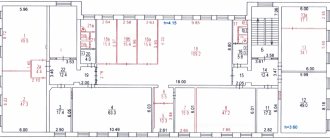Interior doors in a load-bearing wall: is it possible to do it and with whom to coordinate it?
RADA DOORS is in touch!
Let's talk about redevelopment and the possibility of installing interior doors in the load-bearing wall of a house or apartment? Before answering, let us remind you that any redevelopment in the apartment must be coordinated with special services, without this there is no way. The procedure is as follows:
First, write an application for a technical inspection of the apartment. Service representatives will inspect the technical condition of the walls of your and neighboring apartments.
further coordination of the developed project with municipal services such as the Ministry of Emergency Situations, SES, MVK, etc.
After receiving all permits, redevelopment can begin.
Such red tape is associated with the risks that work with load-bearing walls carries. When issuing a permit, the following is taken into account:
house wall material
degree of wear of floors
load on the area where you plan to make the opening
Is it possible in the wall of a panel house?
It is possible to install a door in such a house, but it is problematic. There are reasons for this: 1) the age of the house - if it is more than 20 years old and has never undergone major repairs, you will not receive permission; 2) an old panel house in itself is not the most reliable structure; it does not become stronger over the years.
permission may not be given if the redevelopment of the load-bearing wall has already been carried out by your neighbors on the floor above or below. The openings should not be under each other.
In each region there is a so-called “age limit” for houses, after which redevelopment in the load-bearing wall is not allowed. Homes built before '92, as well as those built after the 2010s, often fall into this category.
But the main reason is that almost all the walls in a panel house are load-bearing. First, find out the series of your house, and then plan redevelopment. Information about this can be found on municipal websites. There will also be information about whether your walls are load-bearing or not.
In the load-bearing wall of a brick house?
Unlike a panel house, it is easier to obtain permission for redevelopment in a brick house, because There are fewer requirements for doors in a load-bearing wall. Here are some of them:
the distance of the new opening from the existing one should not exceed 40 cm.
Lintels must be used over openings.
On the upper floors you can make several openings.
The width of the opening is proportional to the floor. The higher the floor, the larger the doorway can be made.
In the load-bearing wall of a monolithic house and on the 1st floor
Theoretically, it is possible to install a door in a load-bearing wall on the ground floor, but it is problematic. Especially in high-rise buildings. The reason is that the structure has 1 and 2 floors. there is a maximum load, so it is more difficult to obtain permission.
Question details
Variations of openings and finishing options
The opening can be made in both a brick and a panel house - it does not matter significantly. It must necessarily fit into the overall interior of the room. First of all, you should choose the option that you need, and only after that you can start working. Next, let's look at what people are doing and, perhaps, you will choose the appropriate option for yourself if you have not yet decided on it. For example, a doorway can be finished with additional trim, or artificial stone can be used.
Factors for ensuring the safety of redevelopment
Any type of construction work that is associated with the supporting structure of the building must be correctly and accurately calculated. The fact is that the walls of buildings are capable of experiencing colossal loads, and for this reason, the design of the opening should be approached thoroughly. If you make a poor-quality redevelopment, as well as disrupt the technology of the house, this can lead to the fact that the house partially or even completely collapses.
When calculating, you should take into account a number of important factors that will influence the final result:
- Types of materials used to construct the building.
- The technical condition of the building, in particular the floors.
- Thickness of wall load-bearing structures.
- Load on the area with the structure where you plan to make the opening.
- Internal layout of the room.
- The dimensions of the planned opening, as well as how well it will correspond to the dimensions of the walls.
When the project has been calculated and all factors have been taken into account, it must be approved by the supervisory service. Work on moving doorways can begin only after the project has been approved.
Types of openings
Making an opening in the load-bearing wall of a panel/brick house is not so easy. The complexity of the calculations for designing the transfer of a doorway in load-bearing walls will depend on the configuration of the planned opening.
The complexity of the construction work, as well as the order in which it is carried out, will directly depend on which option you choose:
- A standard straight type opening - it is cut into the partition from scratch. In the calculation, it is necessary to take into account the existing doorway, which will take part of the load from the supporting structure. According to the design documentation, this opening should be left untouched or it can be filled with bricks.
- An opening made in the form of an arch is much more difficult to make, and during the calculation you will need to take into account the bending trajectory. Calculations for an arched opening in brickwork will be particularly difficult, because the placement of masonry joints will need to be taken into account.
- Partial transfer of the passage - here it is assumed that the lintel of an existing passage is shifted in the direction you require. You need to cut a new passage fragment of the size you need. The unnecessary part of the opening should be filled with bricks.
Expanding the opening in a load-bearing wall
The very fact of expanding the opening in a load-bearing wall is a more serious matter than carrying out redevelopment due to the opening. In this case, strengthening the opening is the primary task of the event to ensure your safety. When enlarging a doorway in a load-bearing wall, it is important to remember several important points:
- strengthening of support is necessary, the installation of a metal structure will help with this, which will prevent the destruction of the building;
- approval is impossible without a technical report and preparation of a package of design documents, since such redevelopment is not possible in all houses.
If you want to enlarge the doorway in the load-bearing wall in apartments on the top floors, obtaining permission is much easier, due to the lower load on the main walls. The situation is more complicated with the coordination of such work on the lower floors, since the load is much greater and the walls are not designed to carry out such activities.
How to make an opening in a load-bearing wall?
Making a doorway in a load-bearing wall begins with cleaning the surface. All finishing materials are removed, including brick or concrete. The outline of the future opening is drawn on the cleaned wall. At all turns and straight sections, through holes are drilled at short intervals. On the back side of the partition, the outline of the opening is also drawn. The marks are previously made holes that help create an accurate projection.
Before cutting the passage, temporary supports for the ceiling are installed. The supports will reduce the load on the walls and support the floor slabs. Cutting along the markings begins from the bottom up. It is undesirable to use percussion instruments, especially for panel houses.
Tools and materials used
To cut an opening in a main wall, you will need a cutting tool. The simplest option is a grinder with a diamond blade. Professionals use a wire saw or diamond-coated circular saw. Make holes with a powerful electric drill. Drills are used with diamond tips in the shape of a cone or square.
Additionally, you will need a hammer, pry bar, sledgehammer, level, and marking tool.
The materials are used to prepare a channel, angle and steel strips. Metal will be needed to strengthen the new opening.
Panel house
Cutting an opening in the load-bearing wall of a panel house begins with arranging a lintel. A through slot is made along the horizontal marking line. Its length should be greater than the width of the passage in the wall. The protrusion is needed so that the lintel has reliable support beyond the boundaries of the opening. A metal corner is inserted inside the slot on both sides of the wall. To prevent the two halves of the lintel from moving apart, through holes are drilled through the wall and tightened with long bolts. The finished metal structure is walled up with concrete.
Further work continues after the solution has hardened. Cutting is carried out using a grinder with a diamond blade. First they follow the entire marking on one side of the wall, then move to the other side. The cut section is cut into squares to make them easier to dismantle. Each segment is carefully knocked out with a sledgehammer. Defects at the ends of the opening are smoothed out with a grinder.
Brick house
To make a passage in a load-bearing brick wall, perform similar actions. The difference is the marking. It is advisable to place the lines at the seams of the masonry. The upper jumper from the corner is inserted into the space between the seams. Wall cutting can be done using diamond-coated drills. First, the mortar is drilled into the seams, and then the masonry is dismantled using a pry bar.
Moving a doorway
Apartments in multi-storey buildings built in the Soviet era according to standard designs often have inconvenient layouts, which sometimes makes it difficult to arrange furniture and makes the room uncomfortable for living.
One way to change this situation is to move the doorway in the interior partition. How simple or complex this procedure will be depends on the characteristics of the residential building and the type of structure.
It is worth considering that sealing an existing doorway and cutting a new one is a redevelopment that requires approval in accordance with the procedure established by law.
Often during redevelopment, the doorway in the bathroom is moved. This is a necessary measure when expanding the bathroom and toilet into the corridor or when separating a combined bathroom.
Find out more about expanding the bathroom in your apartment.
There are two types of redevelopment involving the relocation of a doorway in an apartment:
- Relocating a doorway in a load-bearing wall.
- Relocating a doorway in a non-load-bearing wall.
Relocating a doorway in a non-load-bearing partition
Today, in construction and repair, craftsmen use modern tools and technologies that allow them to cut an opening of any shape and complexity in walls made of a variety of materials in the shortest possible time. However, in order to avoid getting into serious trouble with the law once you get the desired layout in your apartment or office, it is better to pre-coordinate all changes in the configuration of the premises with government agencies.
Previously, to transfer a doorway in a partition that is non-load-bearing, only a sketch was enough. Now the mandatory development of project documentation is required.
If redevelopment with the relocation of a doorway is planned in a building with mixed floors (old foundation), you will also need a technical report (TOR) on the condition of the structures in the room and the possibility of carrying out repair work, since in old buildings non-load-bearing partitions become load-bearing over time .
Legally, only a self-regulatory organization can legally handle the design of a redevelopment project that involves relocating a doorway, and the technical specifications will need to be ordered from the developers of the house or from the State Unitary Enterprise MoszhilNIIproekt.
As a building material for interior partitions, as a rule, bricks, foam blocks and plasterboard are used, which are used to cover a wooden/metal frame.
The procedure for filling an existing opening relates to redevelopment, since these changes are also made to the plans of the Bureau of Technical Inventory.
Coordination of moving a doorway in a load-bearing wall
According to PPM No. 508, sawing an opening in a load-bearing wall can only be done upon receipt of the appropriate permission from government authorities. In Moscow, the housing inspectorate deals with the approval of redevelopment. No one else has the right to issue permission to carry out such repair work.
The possibility of coordinating the transfer of a doorway depends on the type of house, its design features and condition.
Panel houses
Almost all the walls inside the apartment of a panel house are permanent. They act as supports for floor slabs and ensure the stability of the entire building. At the same time, the interior walls on the lower floors have to support a much larger total weight.
Therefore, it is more likely to obtain approval from the licensing authorities to move the doorway in apartments located on the upper floors of the building. However, this is not a rule, since much in this situation depends on the condition of the affected wall and the structures associated with it, on similar changes that were made in the layout of neighboring apartments (above and below), etc.
The combination of all these factors makes moving a doorway in a panel house a difficult and sometimes impossible task.
For example, in panel houses developed by JSC MNIITEP and in operation since 2007, it is prohibited to carry out redevelopment with interference in the load-bearing structures of the building. These “sockets” are designed using a new technology that protects the building from progressive collapse. And when installing doorways in load-bearing walls (not provided for in the basic design), it is violated. Therefore, MNIITEP, as the developer of the house project, prohibits such redevelopment. And without his approval, it will not be possible to obtain permission to move a doorway in a load-bearing wall.
These restrictions do not apply to houses whose developer is not JSC MNIITEP. And also for residential buildings designed by OJSC MNIITEP, but built before 2007. In this case, such redevelopment can be performed, but in compliance with current regulatory requirements:
- A new opening in a main wall can be cut at a distance of at least one meter from an existing opening. The width of the wall should be the same.
- The width of a standard opening is 0.9 m. Occasionally in some series of houses it can reach 1.2 m.
Types of redevelopment that do not require approval
The article tells what redevelopment does not need to be approved in 2021 and explains the intricacies of the legislation.
What kind of redevelopment does not require permission?
Some home improvements can be done without approval. These are works that do not affect the main structures of the house and are not associated with changes in the area of the premises.
7 works for which you do not need to obtain permits:
- glazing of loggias;
- wallpapering;
- installation of air conditioners;
- replacement of plumbing equipment;
- installation of a hood;
- laying laminate;
- replacement of linoleum.
There are other improvements that can be made without notifying the authorities. But owners often want drastic changes in order to create more comfortable living conditions. What is involved in refurbishment?
There are certain limits of permitted behavior for homeowners. You can do a limited list of actions to repair an apartment without permission. But if your imagination goes further, you will have to think about coordinating repairs.
5 main actions that constitute a change in layout:
- combining a bathroom;
- combining the loggia and the residential area;
- moving or eliminating walls;
- installation of a shower cabin;
- transfer of heating radiators.
Redevelopment can be legitimized after the fact, but this will be more difficult to do. It is possible that the housing inspection will not approve the transformation, and the owner will have to return the property to its previous form at his own expense.
Consequences of unauthorized reorganization
Some citizens improve at their own discretion and live this way for years, but sometimes it happens that the deception is revealed. For example, when selling a home. It happens that a shower stall is installed, and no one will know about it. But if the neighbors are suddenly flooded, then information about the reconstruction may well become known to government agencies.
Important! The violator will have to pay a fine of up to 2.5 thousand rubles. and try to legitimize their actions after the fact. If the attempts are unsuccessful, the housing will have to be returned to its original form.
Do I need permission to rebuild non-load-bearing walls?
The redevelopment of the apartment is conceived with the aim of improving the living conditions of citizens. The question arises: can the structure of non-load-bearing walls be affected or not?
Simple renovations can be done without permission if you follow the basic rules.
2 actions that cannot be done without permission:
- enlarge the bathroom;
- move plumbing fixtures outside the bathroom.
After the work has been carried out, they need to be recorded in the technical inventory bureau, and then legalized through the Moscow Housing Inspectorate.
You can do without permission if non-load-bearing partitions are dismantled and then put back together again. It is allowed to improve the quality of partitions. For example, make new partitions from brick or other durable material.
At the same time, the reconstruction of the walls in the apartment will not have to be formalized if the technical passport of the BTI remains unchanged. When the configuration changes, the work requires approval.
Do I need permission to remove or move a non-load-bearing wall?
There are several types of work that must be formalized:
- partial removal of non-load-bearing fencing;
- creation of additional partitions. For example, arranging a study or dressing room;
- removing a partition to combine the living area and kitchen;
- transformation of load-bearing structures.
Redevelopment without approval is fraught with adverse consequences. Therefore, to legalize them, you should contact the administration or housing inspection staff. The application may be submitted through intermediaries - the government center
Coordination of moving the doorway
It would seem that the doorway can be easily moved, because the layout of the home remains the same. In fact, the list of what kind of apartment redevelopment can be done without permission is not that long.
To change the location of the doorway, you must obtain a permit. The area remains the same, but the layout of the apartment is adjusted. Those. the BTI plan contains a specific layout of the doorway. But it is changing, so you need to get permission to work.
But you can get by with drawing up one sketch if the new design is made in the same place, and only the location for installing the doorway changes.
What changes will have to be abandoned?
What redevelopment is permitted is determined by law. Do's and don'ts must be followed by apartment owners. After all, a repair team can carry out almost any project for money. But whether such actions will be legal is another question.
3 prohibited techniques for changing the layout:
- placing a bathroom above the living rooms;
- connecting floor heating to general heating systems;
- connection between the room and the kitchen with a gas stove.
If the common property is annexed, then such actions are contrary to the law. Apartment owners have the same rights to the property of an apartment building.
Actions that threaten the integrity of the building and the normal operation of engineering structures are prohibited.
How to arrange a reorganization
It happens that the owner thought that the actions taken did not require approval, but he was mistaken. When selling a home, the changes will still have to be formalized, because there may not be anyone willing to buy the property “with a surprise.”
You can obtain permission from the housing inspectorate. If attempts are unsuccessful, you will have to go to court.
But if prohibited repair techniques were used, then the court’s decision will be negative.
Remodeling your home requires costs. It is necessary to pay for the services of the company to produce the project. If you go to court, the costs will increase. You will have to pay a state fee, a fine and bear the costs of a representative if you hire a lawyer. Therefore, before remodeling, you should clarify when changing the layout of an apartment does not require permission, and when it is definitely needed.
How to save money on remodeling
Creating an individual project will cost a large sum. But Moscow residents have the opportunity to take advantage of one of the standard projects. Samples are posted on the official portal of the Moscow Housing Inspectorate. These projects are free. But the condition of the applicant’s apartment and his neighbors is being checked. If unauthorized changes are discovered among neighbors, then use of the project may be refused.
Cost of moving a doorway
We are often asked how much does it cost to move or move a door? It can be difficult to answer this question unambiguously without considering a specific situation, because the price of moving a doorway is influenced by several factors:
- The thickness of the wall in which a new opening will be cut and the existing one will be laid.
- Type of wall (what material it is made of).
- The need to strengthen the new opening.
- The complexity of the work on metal reinforcement of the opening as part of a previously agreed upon redevelopment project.
Bonus: what to do if you can’t move the opening
If for some reason you had to abandon the idea or you were put off by the labor-intensive and lengthy process, you can try other options. For example, to make the ceiling visually higher, it is not necessary to increase the opening. You can place a false transom over it.
In a small space, it is not necessary to widen the opening - try removing the door if it leads to a family room. This way the interior will look lighter, and you will walk faster and more freely.
Instagram: @rio_remont.ru
Instagram: @rio_remont.ru
In what cases is it possible to obtain permission for redevelopment?
In the decision-making process, the housing inspection considers the following characteristics of the apartment and house:
- The floor on which the apartment is located and the total number of floors of the building - the higher the apartment is located, which means the less load on its floors, the higher the likelihood of obtaining permission.
- Year of construction of the building - if the building is old, its structures have become dilapidated due to natural wear and tear, the installation of an opening in this case can be dangerous.
- Opening size - the future opening should not be too large, the standard width is 90 cm.
- The condition of the walls in apartments above or below (can be seen on the floor plan of all apartments along the riser from the first to the top floor) - if your neighbors on the riser have already made an opening in this wall, the likelihood of obtaining permission is reduced. There is a loophole - the construction of an opening exactly under the neighbor's opening.
- Coincidence of the opening with the joints of the floors - the construction of openings in such parts of the wall is prohibited.
- The presence of a setback from the outer wall of at least 1 meter.
Most of the situations presented are not hopeless. Our specialists will find an opportunity to legally coordinate redevelopment in the city of Moscow.
The approval of the opening and its subsequent opening are carried out only if the owner has a project for future redevelopment in hand. Before looking for a design organization, you need to find out whether it is possible in principle to install an opening in your home.
Since 2007, in houses designed by the State Unitary Enterprise "MNIITEP", the construction of new openings in load-bearing walls has been prohibited. An exception is some three-room apartments with a transformable wall, which provides an opening between the room and the kitchen.
Apartment redevelopment 2020 - what is possible and what is not?
Redevelopment of an apartment - what is possible and what is not - Permission from the housing inspection for repairs
In this article we will look at what can and cannot be done when remodeling an apartment for 2021.
In short, when remodeling apartments, you can carry out only those activities that are not prohibited by existing SNiPs, SanPinas, codes of rules and regulations of the Government of Moscow or the Russian Federation.
That is why we will begin by listing the works prohibited for production, for which it is impossible to obtain approval for redevelopment.
We also recommend that you study the page “What is redevelopment of an apartment?” You can see which works need to be approved according to the project, and which according to the “sketch” here.
If you have any questions about your redevelopment, you can always call us by phone. We will be happy to answer any of your questions.
You can also send us any apartment plans before and after remodeling by email.
We will evaluate the possibility of agreeing on such redevelopment and will be able to send a commercial proposal for its approval.
What not to do when remodeling an apartment?
The list of activities that are prohibited from being carried out when renovating an apartment and for which it is impossible to obtain appropriate permission is listed in paragraph 10 of Appendix 1 to Moscow Government Decree No. 508. Point 10.
9 from this list also says that redevelopment should not violate SNiPs, SanPiNs, Decrees of the Government of the Russian Federation and other regulatory documents.
First, let's look at all the activities that are prohibited by Decree No. 508:
- any measures leading to a deterioration in the living conditions of third parties or limiting access to public communications. This, for example, includes the transfer of heating risers, hot and cold water supply, lining these risers with solid boxes without hatches for inspecting the condition of the pipes;
- violation of the building's load-bearing capacity. This paragraph says that in no case should you dismantle load-bearing walls or create openings in them without obtaining the appropriate permission for repairs;
- insertion of disconnecting or control devices into public communications;
- reducing the cross-section or dismantling ventilation ducts. Often, apartment owners do not plan to touch the ventilation ducts themselves, but want to reduce the ventilation shaft, which has a lot of empty space in addition to the pipes themselves. It is very difficult to reconcile this. The area inside the ventilation shaft is not included in the area of the apartment and, therefore, the owner of the apartment did not buy it and it does not belong to him. In accordance with paragraph 1 of Article 36 of the Housing Code of the Russian Federation, this empty area inside the mine belongs to common property. In accordance with paragraph 5 of Appendix 3 of the Resolution of the Moscow City Council No. 508, in order to annex this area, it is necessary to organize a meeting of all owners of premises in an apartment building, at which they will decide to transfer this area for free use or rent. In addition, it is necessary that at least two-thirds of all apartment owners in the entire building vote positively. Organizing such a meeting is in most cases impossible. There is free space inside the mines due to the fact that the architect of the house works out the layout of the apartments when designing the house and takes the areas with a reserve, since he does not know what pipes and what cross-section the related engineers will need to lay, designing ventilation, water supply and sewerage, etc. .;
- increasing the load on the floors when pouring screed or replacing the partition material with heavier ones. This paragraph applies mainly to houses with wooden floors, in which it is impossible to pour screed into the floor, as well as install Jacuzzis, bathtubs, partitions made of foam blocks without carrying out verification calculations;
- transferring a water heating radiator to a balcony or loggia. At the same time, it is possible to install warm electric floors or radiators on the balcony;
- installation of water floors from heating or hot water supply systems. Again, no one prohibits the installation of electric heated floors;
- affecting or partial dismantling of load-bearing columns, pylons or stiffening diaphragms;
- installation of fines in load-bearing walls;
- installation of loggias on all floors except the first;
- redevelopment of the attic or technical floor, if they do not belong to your property. Many owners of apartments on the top floors want to partially attach the attic and make a staircase from the apartment to it. Unfortunately, this clause prohibits such redevelopment;
- combining a gasified kitchen with a living room;
- constructing an opening in the partition between the gasified kitchen and a room without a door;
- any interference with load-bearing walls, including the construction of an opening, without agreement with the organization that designed the building;
- combining loggias and balconies with interior spaces;
- affecting external walls with weakening of the building’s load-bearing capacity;
- installation of more than one mezzanine in the room;
- arrangement of a bathroom, toilet, shower, toilet and kitchen on the mezzanine;
The Housing Inspectorate's refusal to issue permission for redevelopment due to non-compliance with standards.
First steps when moving a doorway
Any change in the space of the apartment must be reflected in the housing plan and registered in the BTI department. Without completing the appropriate documents, serious troubles will arise in the future. The standard punishment for violators is a legally fixed obligation to restore the original layout. In exceptional cases, more severe measures are possible, up to and including a court decision to deprive the right to housing, if the changes made seriously threaten the life and health of the remaining residents.
You can save yourself from the troubles associated with the desire to rebuild an apartment at your own discretion only by completing the required documents with the relevant authorities.
The transfer of openings provides two options - work on a load-bearing and non-load-bearing wall. In both cases, registration of changes is required. Operations on a non-load-bearing wall are regulated relatively loosely. It is enough to coordinate the project with the service organization. If work is planned on a load-bearing wall, then resolving this issue may take months. Note that one of the points of agreement is an expert assessment of the project by the author of the building.
Contacting a construction company specializing in such work will speed up the procedure. Established contacts and experience of employees will help in promoting the project through the authorities. It will cost more, but you can save time and nerves.
Procedure
If you cannot do without changing the location of the entrance opening, be patient.
You'll have to run through the authorities:
- Obtain signatures from residents. Nothing will happen without the consent of the homeowners.
- Obtain the consent of the authors of the project.
- If the wall is load-bearing, then draw up a project, develop documentation and approve it (technical conclusion).
- Get permission from the housing inspector.
- Go to the BTI to make changes to the documentation of the apartment building.
Opening in load-bearing wall
For the rational use of premises, it is often necessary to construct an opening in a load-bearing wall, to organize an isolated room from a passageway, to interact between rooms, to expand an existing opening or to shift it.
The construction of an opening in a load-bearing wall is possible in houses of panel series, brick, monolithic. The layout of the opening is approximately the same for all types of houses, cutting out a part of the load-bearing wall under the doorway and reinforcing it with a metal structure. The design of the reinforced frame differs depending on the type of house, because The thickness of the walls is different.
Doorway in a panel house
Most often, the construction of an opening in a load-bearing wall is found in panel serial houses; as a rule, an opening is cut between the kitchen and the room, in order to create a kitchen-living room and enlarge the bathroom due to the corridor. It should be noted that the construction of an opening in the load-bearing wall of panel serial houses, the author of which is MNIITEP, is permitted only if they were built before 2007; after this date, affecting the load-bearing structures in these houses is not allowed.
The construction of an opening in houses for which MNIITEP is not the author of the project, also brick, monolithic, individual series, is allowed regardless of the year of construction.
Is it possible to do?
Determining the possibility of constructing an opening in a load-bearing wall is carried out through an inspection of the structures of a residential building, by the author of the house project, with the issuance of a Technical Conclusion. The technical report will contain the possibility of constructing an opening, its location and size. The number of openings in panel serial houses, as a rule, is allowed one, in the rest it is determined individually by the author of the house project. There are factors that can influence the impossibility of creating an opening, such as a very low floor, the presence of completed openings in the neighbors of the apartments above or below, the presence of previously completed openings in the apartment in question, the presence of utilities in the wall. If the author of the house project does not exist at this time, there are a number of Moscow institutes that have the right to act for the author and prepare all the project documentation.
Coordination of the opening
During the preparation of the Project, the design of the metal reinforcement frame, the composition of the material and the procedure for its installation will be developed. The opening is cut out and reinforced with a metal structure by a construction organization authorized to carry out these types of construction and installation work, having an SRO, with the mandatory execution of Certificates for hidden work after completion. The actual execution of work occurs after receiving the appropriate Permit from the Moscow Housing Inspectorate.
Our company provides assistance in preparing all the documentation for constructing an opening in a load-bearing wall; the cost can be found by phone or in the price section.
PRO new building 7 (499) 450-27-46 (Moscow)
- Relocation or replacement of household appliances (washers, dryers, dishwashers, boilers);
- Moving floor-mounted household electric stoves within the kitchen;
- Replacement of the final floor covering;
- Glazing of balconies;
- Installation of a low-power household air conditioner;
- Cosmetic finishing of the room, in particular, replacement of the finishing coating of the ceiling, walls, floor, as well as replacement of external elements, if the design and color are preserved;
- Work on installation and dismantling of built-in furniture. It should be taken into account that built-in wardrobes may be reflected in the floor plan, which means the need to coordinate the disassembly or relocation of such furniture.
If an illegal redevelopment of an apartment is discovered (for example, in the event of an emergency, during an inspection, or as a result of denunciation by neighbors), the owner may face a significant fine. The redevelopment will have to be legalized within 3 months, otherwise the owner will be fined again. If the identified redevelopment was carried out in violation of the requirements, the owner will be obliged to return the premises to its original form and compensate for the damage caused to other residents. Failure to comply with this requirement will entail the sale of the apartment at auction, eviction and deprivation of ownership.
This is interesting: Reduction Coefficient for Military Pensioners in 2021










